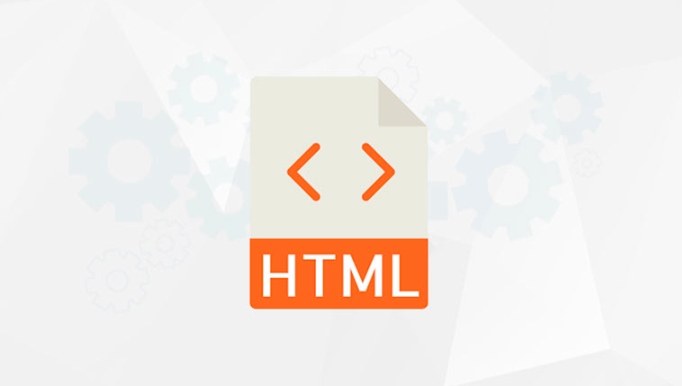Web Worker is a multi-threaded solution provided by HTML5, allowing JavaScript to run in background threads to avoid blocking the main thread. It improves page response speed by executing time-consuming tasks such as data calculations, network requests, etc. through independent threads. 1. Worker cannot operate DOM or use window/document objects; 2. Use postMessage and onmessage to achieve main thread communication; 3. It is suitable for complex computing, timing tasks, parallel processing and other scenarios; 4. Notes include not loading scripts across domains, not being able to use synchronization methods such as alert, and message delivery is restricted by structured cloning. Rational use of Web Worker can significantly optimize performance bottlenecks.

Web Workers is a technology used to run JavaScript in HTML5 in background threads. That is to say, it allows your web page to perform some time-consuming tasks, such as data calculations, network requests, etc. without blocking the main thread. In this way, the page will not be "stuck" because the script is executed for too long, and the user experience will naturally be better.

What is a Web Worker?
Simply put, Web Worker is a JavaScript file that runs independently in the browser background. It runs on different threads from the main page, so it will not affect the page's response speed.
You may encounter a situation where a complex computing task makes the entire page stutter, the buttons are not clicked, and the animation is stopped, because JS is executed by a single thread. Web Worker is here to solve this problem.

It should be noted that Worker cannot operate the DOM directly, nor can it use window or document objects. Its operating environment is relatively independent and can only communicate with the main thread through the message mechanism.
How to create and use Web Worker?
To use Web Worker, you first need to create a separate JS file that writes the code you want to run in the background. Then instantiate a Worker object in the main page and pass the data through postMessage and onmessage .

For example:
// main.js
const worker = new Worker('worker.js');
worker.onmessage = function(event) {
console.log('Received message:', event.data);
};
worker.postMessage('Start Work'); // worker.js
onmessage = function(event) {
console.log('Worker received:', event.data);
postMessage('Task Complete');
}This completes the most basic Worker message interaction. In practical applications, you can place complex calculations, polling, timing tasks, etc. here to execute.
What common problems can Web Worker solve?
Long-term tasks cause page stuttering
For example, encryption and decryption, image processing, large-scale data sorting, etc., these can be put into the Worker to perform.Avoid blocking user interaction
If your page has timers or long loop tasks, putting it in the main thread will seriously affect the UI response, and Worker is very suitable at this time.Handle multiple tasks in parallel
Although JavaScript itself is single-threaded, Web Worker allows you to achieve "pseudo-multi-threaded" effects and improve overall performance.
Of course, not all tasks are suitable for worker. For example, tasks involving frequent DOM updates are not suitable because Worker cannot operate the DOM directly.
Notes on using Web Worker
- Worker cannot load scripts across domains and must come from the same source.
- Synchronous blocking methods such as
alert()orconfirm()cannot be used in Worker. - Message delivery is asynchronous, so pay attention to structured cloning restrictions (such as not being able to pass functions).
- Don't abuse Workers, each Workers will take up extra memory and resources.
If you are just doing some simple delay or timing tasks, you don't need to use Worker. But if it involves a lot of computing or long-running logic, it is worth considering moving it to the backend to do it.
Basically that's it. Web Worker is not complicated, but can easily be overlooked, especially in the early stages of development. When you find that the page is slowing down but cannot find obvious bottlenecks, it may be time to consider using Worker to move some tasks out.
The above is the detailed content of What are Web Workers in HTML5?. For more information, please follow other related articles on the PHP Chinese website!

Hot AI Tools

Undress AI Tool
Undress images for free

Undresser.AI Undress
AI-powered app for creating realistic nude photos

AI Clothes Remover
Online AI tool for removing clothes from photos.

Clothoff.io
AI clothes remover

Video Face Swap
Swap faces in any video effortlessly with our completely free AI face swap tool!

Hot Article

Hot Tools

Notepad++7.3.1
Easy-to-use and free code editor

SublimeText3 Chinese version
Chinese version, very easy to use

Zend Studio 13.0.1
Powerful PHP integrated development environment

Dreamweaver CS6
Visual web development tools

SublimeText3 Mac version
God-level code editing software (SublimeText3)

Hot Topics
 What is Microdata? HTML5 Explained
Jun 10, 2025 am 12:09 AM
What is Microdata? HTML5 Explained
Jun 10, 2025 am 12:09 AM
MicrodataenhancesSEOandcontentdisplayinsearchresultsbyembeddingstructureddataintoHTML.1)Useitemscope,itemtype,anditempropattributestoaddsemanticmeaning.2)ApplyMicrodatatokeycontentlikebooksorproductsforrichsnippets.3)BalanceusagetoavoidclutteringHTML
 Microdata in HTML5: The Key to Better Search Engine Ranking
Jun 12, 2025 am 10:22 AM
Microdata in HTML5: The Key to Better Search Engine Ranking
Jun 12, 2025 am 10:22 AM
MicrodatasignificantlyimprovesSEObyenhancingsearchengineunderstandingandrankingofwebpages.1)ItaddssemanticmeaningtoHTML,aidingbetterindexing.2)Itenablesrichsnippets,increasingclick-throughrates.3)UsecorrectSchema.orgvocabularyandkeepitupdated.4)Valid
 Audio and Video: HTML5 VS Youtube Embedding
Jun 19, 2025 am 12:51 AM
Audio and Video: HTML5 VS Youtube Embedding
Jun 19, 2025 am 12:51 AM
HTML5isbetterforcontrolandcustomization,whileYouTubeisbetterforeaseandperformance.1)HTML5allowsfortailoreduserexperiencesbutrequiresmanagingcodecsandcompatibility.2)YouTubeofferssimpleembeddingwithoptimizedperformancebutlimitscontroloverappearanceand
 Audio and Video : What about browser compatibility?
Jun 11, 2025 am 12:01 AM
Audio and Video : What about browser compatibility?
Jun 11, 2025 am 12:01 AM
Browser compatibility can ensure that audio and video content works properly in different browsers by using multiple formats and fallback strategies. 1. Use HTML5 audio and video tags and provide multiple format sources such as MP4 and OGG. 2. Consider automatic playback and mute strategies and follow the browser's policies. 3. Handle cross-domain resource sharing (CORS) issues. 4. Optimize performance and use adaptive bit rate streaming media technologies such as HLS.
 Audio and Video: can i record it?
Jun 14, 2025 am 12:15 AM
Audio and Video: can i record it?
Jun 14, 2025 am 12:15 AM
Yes,youcanrecordaudioandvideo.Here'show:1)Foraudio,useasoundcheckscripttofindthequietestspotandtestlevels.2)Forvideo,useOpenCVtomonitorbrightnessandadjustlighting.3)Torecordbothsimultaneously,usethreadinginPythonforsynchronization,oroptforuser-friend
 Adding Audio and Video to HTML: Best Practices and Examples
Jun 13, 2025 am 12:01 AM
Adding Audio and Video to HTML: Best Practices and Examples
Jun 13, 2025 am 12:01 AM
Use and elements to add audio and video to HTML. 1) Use elements to embed audio, make sure to include controls attributes and alternate text. 2) Use elements to embed video, set width and height attributes, and provide multiple video sources to ensure compatibility. 3) Add subtitles to improve accessibility. 4) Optimize performance through adaptive bit rate streaming and delayed loading. 5) Avoid automatic playback unless muted, ensuring user control and a clear interface.
 What is the purpose of the input type='range'?
Jun 23, 2025 am 12:17 AM
What is the purpose of the input type='range'?
Jun 23, 2025 am 12:17 AM
inputtype="range" is used to create a slider control, allowing the user to select a value from a predefined range. 1. It is mainly suitable for scenes where values ??need to be selected intuitively, such as adjusting volume, brightness or scoring systems; 2. The basic structure includes min, max and step attributes, which set the minimum value, maximum value and step size respectively; 3. This value can be obtained and used in real time through JavaScript to improve the interactive experience; 4. It is recommended to display the current value and pay attention to accessibility and browser compatibility issues when using it.
 HTML audio and video: Examples
Jun 19, 2025 am 12:54 AM
HTML audio and video: Examples
Jun 19, 2025 am 12:54 AM
Audio and video elements in HTML can improve the dynamics and user experience of web pages. 1. Embed audio files using elements and realize automatic and loop playback of background music through autoplay and loop properties. 2. Use elements to embed video files, set width and height and controls properties, and provide multiple formats to ensure browser compatibility.






